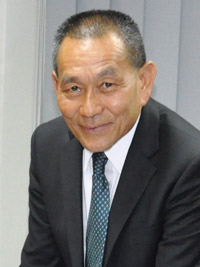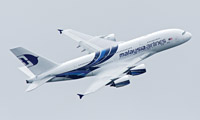Cover Story
WILL MAS TURN THE TIDE AGAIN?
Malaysia Airlines has been on a roller coaster ride in the past six years, from near bankruptcy in 2005 to record profits in 2007, then back to losses by 2010. Today, the ink remains red, but chief executive, Ahmad Jauhari Yahya, is pushing ahead with a business plan designed to make MAS more competitive in today’s volatile markets
November 1st 2012
It was officially signed, sealed and delivered. From November 26, Malaysia Airlines (MAS) would begin serving Sydney from Kuala Lumpur daily with one of its new A380s, offering travellers from Australia a super jumbo service all the way to London. Read More »
 |
| 'The market environment remains very challenging for Malaysia Airlines' |
| Ahmad Jauhari Yahya Chief Executive Malaysia Airlines |
But early last month, just weeks before the service was to begin, MAS chief executive, Ahmad Jauhari Yahya, announced that Sydney, as far as the A380 was concerned, was off the schedule.
Why? Because MAS’s first A380 route, a daily service from Kuala Lumpur to London launched in July, had been so successful the plane earmarked for Sydney would fly to the UK instead.
“Encouraged by the success of our current daily A380 operations on this route, we decided to replace the existing B747 daily flights with the A380 to make it a double daily [to London] on the superjumbo,” said Yahya.
It may sound like a simple matter of smart route adjustment, but it reflects the determination of Yahya, who took charge of the ailing national flag carrier in September 2011, to act quickly when opportunity presents itself.
As part of a business plan launched last December, the chief executive oversaw serious route rationalization in late 2011 and early this year, which resulted in 12 loss-making and low-yielding services – an 8% capacity reduction - disappearing from the network.
A major re-fleeting exercise also is underway, with 23 new aircraft, including four A380s, arriving this year.
Radical action was desperately required when Yahya arrived at MAS. He had previously been head of Malaysian energy firm, Premium Renewable Energy.
In the year ended December 31, 2010, MAS had lost $77.1 million and the red ink was spreading. In 2011, the deficit ballooned to $812.3 million. At the beginning of this year, Yahya described the airline as being “in crisis” and that it needed to “stem the losses before going forward”.
However, by the end of the first quarter of 2012, and six months into his job, there were signs the new business plan was working and the plummeting revenue graph was turning upward.
There was an after-tax loss of $55.5 million for the three months, but it was a significant 29% improvement on the $78.6 million deficit in the same period a year earlier. And the result was despite the fact jet fuel was averaging $135 a barrel, compared with $120 in 2011.
For the first half of 2012, MAS’s net loss stood at $168.9 million, 32% better than last year’s interim loss of $249.3 million. In June, the carrier made a small operating profit of $194,400. “This means something to us, even though the amount is small,” said Yahya told Orient Aviation.
 |
| Malaysia Airlines: putting faith in its new A380s to help regain profitability |
“Whilst clearly we have a lot of work to do to re-establish Malaysia Airlines as a profitable airline, the first six months of 2012 have shown some encouraging signs.
“Yield and RASK (Revenue per Available Seat Kilometre) increased 9% and 6% respectively. Fuel costs decreased 10% due to lower consumption arising from a smaller network and lower capacity, while non-fuel costs decreased 7% with the drop in passenger-related costs due to capacity cuts. Our expectation is to build on this solid year-on-year growth for the remainder of 2012.”
He said the much improved results show tough decisions taken earlier to suspend loss-making routes were bearing fruit.
“However, the market environment remains very challenging for Malaysia Airlines, given the increased competition from low-cost and full service carriers, overcapacity in the Asian aviation sector, high fuel costs and the volatile global economy,” said Yahya.
But he believes MAS is leveraging its strengths. As a public-listed company, the carrier won’t speculate on financial results. But it is looking hard at where it spends its money.
It is re-negotiating all contracts as part of lowering its Cost of Available Seat Kilometre (CASK) by 20% in the next three years.
“In the near-term, we are looking at bringing costs down 10%, equivalent to RM300-500 million ($97- $162 million) in savings as part of our structural cost reduction. An example would be reviewing our catering needs following the route suspensions.
“Overall, it is not about cutting costs, but more of managing them and making our resources more productive,” said Yahya.
A fleet renewal programme is well underway. Deliveries of a firm order for 45 B737-800s and 15 A330-300s began in 2010 and continue through this year and 2013.
Older generation B737-400 and A330 aircraft are being removed gradually. MAS has options on 10 B737s and another 10 A330-300s.
The B747-400s are being phased out, replaced by A380s (four operating now and two more next year). B777-200s will disappear within three years, standardizing the twin-aisle fleet around two types, the A380 and the smaller A330.
Yahya said on-time performance had improved along with productivity and efficiency, yields had crept higher and sales and marketing intensified.
MAS, which celebrated its 40th anniversary last month, joined the oneworld alliance at the beginning of the year. However, working with oneworld isn’t the only avenue of collaboration.
While a share swap deal with budget carrier, AirAsia, fell apart after protests from MAS unions, the two airline groups are still working together. In May, they entered into a “supplemental collaboration agreement” to explore areas of mutual need to save money and boost efficiency. Procurement, aircraft component repairs, training, and technical and operational efficiency have been identified as areas of cooperation.
Yahya said the share swap idea progressed little and became a distraction. “For Malaysia Airlines, the collaboration presents an avenue to negotiate for better terms in procurement, to save capital costs by sharing common equipment and services and increasingly selling reserve capacity to other airlines,” he said.
“Ultimately, the collaboration is aimed at promoting the centrality of Malaysia as a hub for tourism and aviation in the region.”
Yahya said the future of the aviation industry “is one of increased competition, increased capacity and continued high fuel costs - and that’s just on the supply side. On the demand side, it is open season for all. Survival is for the fittest in your chosen niche”, he said.
He is convinced MAS has an edge with its Malaysian Hospitality brand. “The playing field has been set. We have a long heritage of survival. We have great products and services. We have the support. But the task will not be easy,” he said.
Yahya said there will be great pressure to focus on the generation of extra revenue and strong cost management to accelerate financial recovery.
“We are increasing revenue generation through aggressive marketing, promotions and branding initiatives, as well as increasing fleet utilization and adding frequencies to popular regional destinations,” said the chief executive.
“In managing costs, our emphasis is to improve operational efficiency by increasing fleet utilization and reducing turnaround times. This is the foundation for Malaysia Airlines to implement a new productivity model, to become the preferred premium carrier. The business plan is working.”